May 27, 2014 | BEP, currency, dollar, education, news, video
Time has come that there is once again change coming to the money in your pocket. This one is so subtle that you may not even notice the difference.
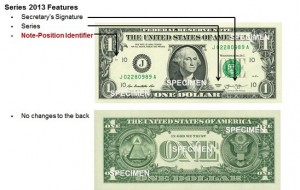
Changes to the $1 Note
For those who do not collect currency, the note-position identifier is the little letter followed by a number that identifies where on the sheet the note was printed. On the $1 FRN, the note position identifier is on the left side of the front of the note under the “1” and next to the Federal Reserve branch number.

Change in the Note Position Identifier
As part of this change, the BEP is also changing the position identifier code mechanism. On the 32 note sheets, the notes printed four-across and eight-down were divided into four eight-note blocks (or quadrants). Each block was given a number in columns where the top-left quadrant was #1, the bottom left was #2, top-right was #3, and bottom-right was #4. Within the quadrants, the note positions were lettered A-D in the first column and E-H in the second column. If you found a note with the note-position code of H3, the note would have been printed in the fourth row and fourth column of the sheet.
The new 50 note sheets simplifies the note-position numbering by assigning a letter to each of the 10 rows (A-J) and a number to each of the five columns. On this sheet, H3 would now be located on the eighth row and third column.
Position Identification layout of 32-note sheet
| A1 |
E1 |
A3 |
E3 |
| B1 |
F1 |
B3 |
F3 |
| C1 |
G1 |
C3 |
G3 |
| D1 |
H1 |
D3 |
H3 |
| A2 |
E2 |
A4 |
E4 |
| B2 |
F2 |
B4 |
F4 |
| C2 |
G2 |
C4 |
G4 |
| D2 |
H2 |
D4 |
H4 |
Position Identification layout of 50-note sheet
| A1 |
A2 |
A3 |
A4 |
A5 |
| B1 |
B2 |
B3 |
B4 |
B5 |
| C1 |
C2 |
C3 |
C4 |
C5 |
| D1 |
D2 |
D3 |
D4 |
D5 |
| E1 |
E2 |
E3 |
E4 |
E5 |
| F1 |
F2 |
F3 |
F4 |
F5 |
| G1 |
G2 |
G3 |
G4 |
G5 |
| H1 |
H2 |
H3 |
H4 |
H5 |
| I1 |
I2 |
I3 |
I4 |
I5 |
| J1 |
J2 |
J3 |
J4 |
J5 |
BEP has begun to deliver the new notes to the Federal Reserve currency distribution operations in all 12 Federal Reserve district branches. These new notes will enter circulation as per the policies of each branch. BEP has not said whether they will sell the 50-note sheets as part of their uncut currency products.
The $1 FRN is the first note to be printed on 50-note sheets. Over time, the BEP will transition the printing of other notes to 50-note sheets with the only design change being the subtle change in the note-position identifier.
As part of this change, the Federal Reserve created a video explaining the changes. You can watch the video here:
Images courtesy of the Bureau of Engraving and Printing.
Jan 10, 2014 | coins, currency, shows
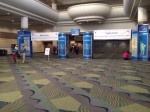 There is more than Disney and Universal in Orlando. This week the Florida United Numismatists Is having their annual convention at the Orange County Convention Center. FUN is the first show of the calendar year.
There is more than Disney and Universal in Orlando. This week the Florida United Numismatists Is having their annual convention at the Orange County Convention Center. FUN is the first show of the calendar year.
If FUN sets the tone for the coming year, what I saw today was a sign for a good numismatic year. Even arriving later than expected, the bourse floor was a steady buzz throughout the day. There was a lot of activity at both the high end and low end tables.
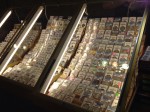
Low Country Coins out of Charleston, SC has a unique way of displaying their coins for sale.
I didn’t buy much today. I spent much of the day schmoozing and looking. Aside from looking at the sale items, I marveled at the items that were not exactly coins. There are quite a few jewelry and other antique items at the show. One thing I noticed was a lot of paper and paper money dealers. While I have seen notaphily and scripophily dealers at other shows, there seems to be quite a few here in Orlando.
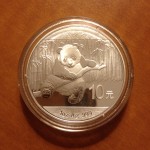
I did buy this 2014 Chinese Silver Panda. I love the Pandas!
In fact, the Heritage Platinum Night Currency auction was held before a full house. While I missed the few colonials I was interested in seeing, I found that the prices realized were well beyond even Heritage’s estimate.
Rather than stand in the back of the room of the currency auction I was not going to bid on, I went to the next room to sit and watch The Adam Mervis Large Cent Collection auction. Aside that I was watching one of the more interesting collection of large cents being broken up, I was enjoying the show being put on by the auctioneers. One of the auctioneers, Bob Merrill, had a great rapport with the audience and really made the auction interesting to watch, even for a non-bidder.
Even though the Heritage auctioneers are good, they seem to miss bids during the furor of the bidding. On more than one occasion with more than one auctioneer, bids were missed that would have significantly jumped the price. Heritage could learn a bit from the classic car and other auctions that are held at large venues and have spotters stand on the floor to help get the attention of the auctioneer. While I have seen this with the big car auctions on television, I have been to estate and bankruptcy auctions in larger places where they use spotters to ensure the bids are noticed.
Dear Heritage: you bring enough people to these auctions, why not add one or two of your people per room to patrol the floor in help the auctioneer. Or why not hire someone to do that at the show. I am sure you can find collectors interested in making a few extra dollars to feed their coin buying habit.
Those following me on Twitter at @coinsblog may have seen many of the pictures I have taken. Eventually, I will post them to Pinterest but I am having connectivity issues. If you want to see the pictures I did take, go to my iCloud Photostream to see all of the pictures, including the ones that did not make it to Twitter. For those who have never experienced an auction, there are two short videos from the large cent auction from where I was sitting.
More FUN tomorrow!
Dec 30, 2013 | auction, coins, currency
This past year saw the high-end market get even higher with the auction of significant rarities bringing in significant prices.
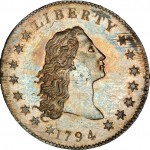
1794 Flowing Hair Silver Dollar sold for a record $10,016,875 to Legend Numismatics
Legend Numismatics’ Laura Sperber took control of the bidding when she invigorated bidding that stalled at $5.5 million when she bit $8,525,000. She called it “shock and awe.” Sperber said that she knew that a $10 million coin would create a huge buzz for the industry and went on to predict that a coin would sell for $25 million before the end of the decade.

1913 Walton Specimen Liberty Head Nickel sold for $3,172,500 on April 25, 2013 to Jeff Garrett of Lexington, Kentucky and Larry Lee of Panama City, Florida.
At the 2003 World’s Fair of Money in Baltimore, a conclave of experts examined the coins for hours, debated, and determined that the coin was real. One of those involved in the marathon meeting was Jeff Garrett, the current Vice President of the American Numismatic Association.
Nearly ten years later, the coin was auctioned for the first time. Graded PR63 by PCGS, the coin sold for $3,172,500 to Jeff Garrett and his business partner Larry Lee.
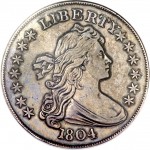
Silver dollar known as “The King of Coins” has sold for more than $3.8 million.
Maybe the discovery of the 1933 Double Eagle coins may have the 1804 dollar beat, but only one version of that coin is legal to own. There are 15 known coins dated 1804 even though they were struck later. In 1834, eight dollar coins were struck with the 1804 date to include in a special set created as a gift for the King of Siam. The set was presented to the King by President Andrew Jackson during trade missions to the Middle East and Asia.
It is known as “The King of Coins.”
The coin is designated as The Mickley-Hawn-Queller Class I Original 1804 Dollar, graded PR62 by PCGS, sold for $3,877,500 to an anonymous bidder.
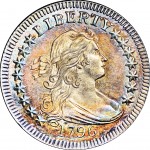
1796 25C MS67+ NGC. CAC. B-2, R.3. Ex: “Col.” E.H.R. Green. The finest certified 1796 quarter.
In case you were curious, according to the Bureau of Labor Statistics Inflation Calculator, $100 in 1931 has the same buying power at $1,533.35 today. Conversely, the $1.5 million sale price is equivalent to $99,618.57 in 1931.
The coin was sold as part of the November 13, 2013 “16 Selections from the Eric P. Newman Collection Part II Signature Auction” held in New York. Proceeds from the sale goes to support the Eric P. Newman Numismatic Education Society.
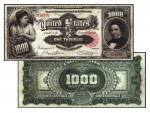
1891 Marcy $1,000 silver certificate (PMG VF25) sells for $2,600,000 by Stacks-Bowers in a private sale.
The note was graded VF25 by Paper Money Guaranty.
The note was sold as part of a collection of more than 85 large-size Silver Certificates that are the finest ever put together. Five notes were sold as part of this transaction. The other 80 went for sale at the 2013 World’s Fair of Money.
Can you imagine what would happen if the Langboard Hoard of 1933 Double Eagles ever make it to the auction block?
Image Credits:
- 1794 Flowing Hair Dollar and 1891 $1000 Silver Certificate images courtesy of Stack’s Bowers Galleries
- 1913 Walton Liberty Head Nickel, 1804 Dollar, and 1796 Quarter dollar images courtesy of Heritage Auctions
Dec 26, 2013 | Canada, currency, Federal Reserve
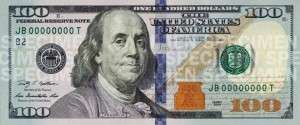 With the fanfare of a hard cough, the Federal Reserve released new new $100 Federal Reserve Notes on Tuesday, October 8, 2013 in the middle of the government shutdown. The launch is three years in the making following of folding problems during production at the Bureau of Engraving and Printing.
With the fanfare of a hard cough, the Federal Reserve released new new $100 Federal Reserve Notes on Tuesday, October 8, 2013 in the middle of the government shutdown. The launch is three years in the making following of folding problems during production at the Bureau of Engraving and Printing.
Earlier on 2013, a Freedom of Information request forced the government to release information as to the problems the BEP was experiencing. The BEP released images along with the report (OIG-12-038 [PDF]) from the Treasury Office of the Inspector General heavily criticizing the BEP for mismanaging the delay. The published response from the BEP was to apologize promising to do better.
As the U.S. Secret Service, Bureau of Engraving and Printing, and Federal Reserve scramble to deal with paper currency, some countries are abandoning cotton rag bond paper for polymer notes.
The polymer “paper” was developed by the Reserve Bank of Australia to enhance the durability of the notes and to incorporate security features not possible with paper or rag-based paper. RBA has been distributing polymer notes since 1992. While the polymer substrate costs little more and the production is only marginally more expensive, the benefit will come from the reduction in counterfeiting and the durability of the note. Polymer will last three-to-six times longer than rag-based paper.
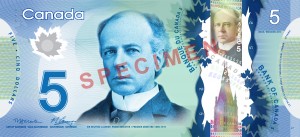
Canada’s $5 Polymer banknote was issued on Nov 7, 2013
The Bank of England announced that they were going to transition to polymer currency notes. The research performed by the Bank of England can be used as a basis for the Federal Reserve to begin its own study.
Although polymer notes may be a better idea, the BEP’s long time ties to Crane & Co. along with politics from Massachusetts will prevent the United States from considering polymer as a viable option. Ironically, there is an indication that the prices of the paper may not be as low as possible. After many yeas of Crand & Co. saying that they are heavy recyclers of cotton, specifically cotton from old denim jeans, we learned that Crane has been sourcing cotton from “beyond the waste stream.” In other words, no more blue jean recycling.
Crane claims the problem is skinny jeans—the pants that many of us should not be wearing! In order to make the clothes tight but comfortable, manufacturers are adding spandex to the fabric so they appear tighter. Spandex and other synthetic fibers cannot be used to make currency because it degrades the strength of the paper. The process to remove the spandex or other “contaminants” is too expensive to be viable.
The United States has tried to use non-paper for currency in the past. In the 1980s, the American Banknote Company worked to Dupont to use its Tyvek polyethylene fiber sheets for currency. Tyvek has had a lot of uses including liners used around insulation during construction and envelopes. It is a strong material that can last much longer than paper. After a number of problems, use of Tyvek was discontinued.
As with the dollar coin, the long memory of the Tyvek failure is a significant detractor to the possibility of just researching the possible move. To paraphrase Thomas Edison, we did not fail in producing currency with plastic, we learned ways of how not to do it! It appears to be unlikely that the United States will be producing polymer notes any time soon.
Last week I went to my local bank asking if they could order the new $100 note from the Federal Reserve. Following two currency deliveries I was told that the notes were not available in the supply chain that supplies my bank in the Maryland suburbs of Washington, DC. Another order was placed with the hopes that they will be available before the end of this year.
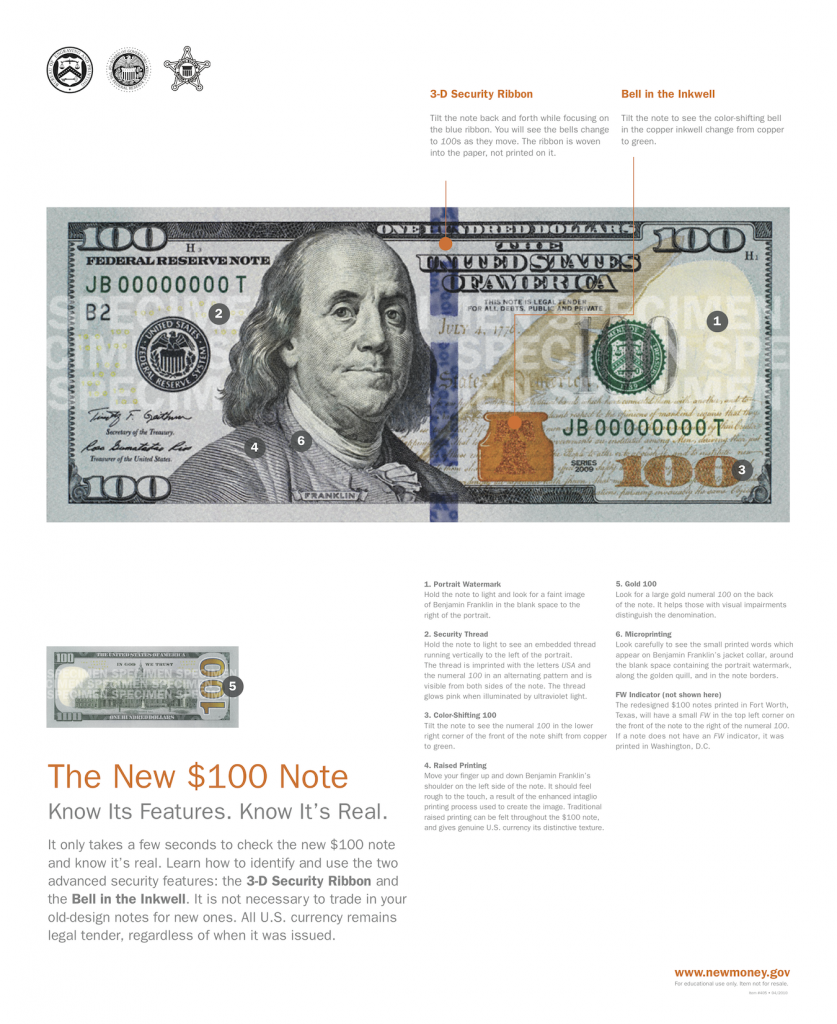
Information from the Bureau of Engraving and Printing as to how to use the new note’s security features to ensure it is not a counterfeit.
Image of new $100 note and counterfeit detection info courtesy of the Bureau of Engraving and Printing.
Image of the Canadian $5 polymer note courtesy of the Bank of Canada.
Dec 22, 2013 | BEP, celebration, commentary, currency, Federal Reserve
It is that time of then when the pundit class of this country puts together their list of the best, worst, or most impactful stories of the year being concluded. There was even an advertisement on satellite radio about an upcoming show that will list the Top 10 moments in music for 2013. After a meeting of the Board of Directors for the Coin Collectors Blog (all three of us: me, myself, and I), the last ten days of the year will count down what we feel are the Top 10 Numismatic-Related Stories of 2013.
Number 10: Lew’s Lewpts
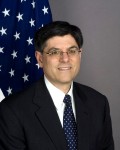
75th Secretary of the Treasury Jacob “Jack” Lew
Lew, whose autograph has been called “lewpty” and been compared to the decorative icing on a Hostess cupcake, made a promise to the president that he would do better with his penmanship. During his confirmation hearing, Lew told Sen. Max Baucus (D-MT), Chairman of the Senate Finance Committee, that he promised the president he would do better. This did not satisfy those with an ironic sense for the different when a petition appeared on the White House website to “Save the Lewpty-Lew.”
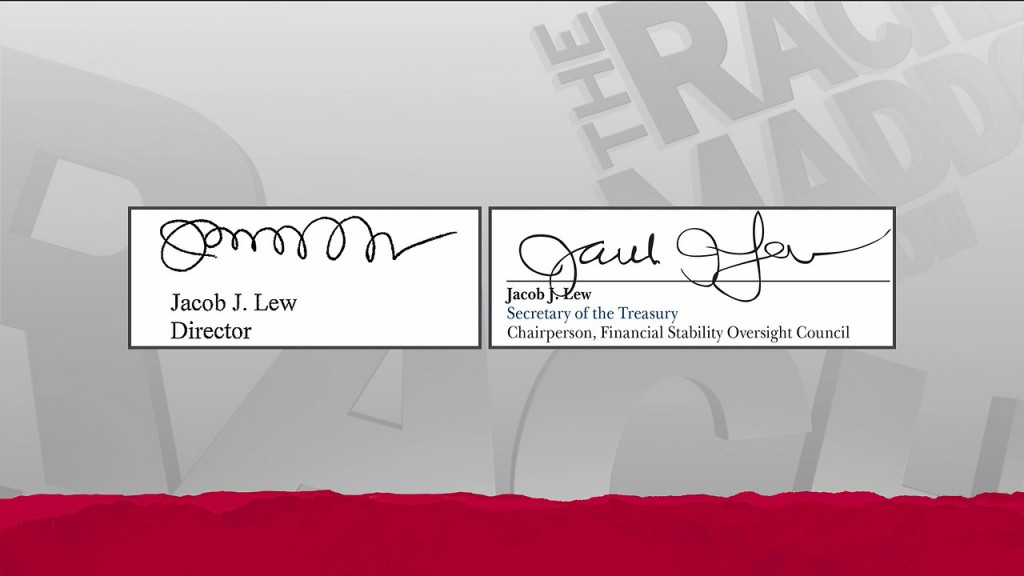
MSNBC on-air comparison of Jack Lew’s autographs: the original Lewpts on the left and what will appear on U.S. currency to the right.
The other signature on U.S. currency is that of Rosa “Rosie” Gumataotao Rios, Treasurer of the United States. Rios was sworn in as Treasurer on August 20, 2009 and has served in that office ever since. Rios’s signature appears with former Secretary of the Treasury Timothy F. Geithner on Series 2009 notes. Ironically, Geithner also changed his signature when he became secretary.
-

-
Tim Geithner’s autograph before becoming Treasury Secretary.
-

-
Tim Geithner’s signature as it appears on U.S. currency
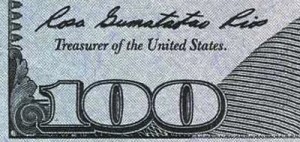
Rosie Rios signature on the older (Series 2009) $100 Federal Reserve Note
Notes that will include Jack Lew’s signature will appear on all Series 2009-A notes.
Glad we were able to resolve this pressing issue!
Dec 7, 2013 | BEP, coins, currency, news, US Mint
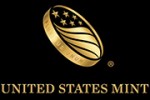 While the products that the U.S. Mint can offer are restricted to what congress allows them to do by law, it does not mean that congress controls how the U.S. Mint markets and sells its numismatic products. To try to get more people to buy its products, the U.S. Mint has made a series of announcements,
While the products that the U.S. Mint can offer are restricted to what congress allows them to do by law, it does not mean that congress controls how the U.S. Mint markets and sells its numismatic products. To try to get more people to buy its products, the U.S. Mint has made a series of announcements,
Free is still better
U.S. Mint’s Black Friday and Cyber Week sale of FREE SHIPPING for items sent via standard shipping that was supposed to end at 5:00 PM ET today, December 6th, has been extended to5:00 PM ET on December 17th. The U.S. Mint cited they are doing this for holiday “shoppers seeking online deals and discounts.” December 17 is also the first day of sale of the 2013 Teddy Roosevelt Coins and Chronicles set. Those interested in the Coins and Chronicles set can have it shipped free if they order the set on December 17.
New brick and mortar storefront
Last month, the U.S. Mint “partnered” with the Bureau of Engraving and Printing by cross advertising each other’s products on their websites. Essentially, these Department of the Treasury bureaus created a page on their respective websites pointing to each other.

Bureau of Engraving and Printing Washington, D.C. Headquarters
Credit for this move can probably be given to Deputy Director and Acting Director of the U.S. Mint Richard Peterson, Director of the Bureau of Engraving and Printing, Larry Felix, and Treasurer of the United States Rosie Rios. What makes this interesting is that Peterson and Felix are career government employees and were not appointed by the President.
Peterson began his work with the U.S. Mint in 2009 when he was hired as their Associate Director of Manufacturing.
Felix, a long-term professional employee of the Bureau of Engraving and Printing, has been the bureau’s Director since January 2006.
Although Rios was appointed by President Obama and took office in August 2009, has not been the prototypical political appointee. Rios has been outspoken in her support of the numismatic community and seeks out ways to participate. She is a staple at coin and currency shows autographic Series 2009 $1 Federal Reserve Notes that bear her signature—something she calls “Rosi notes.&rdquots; It would not be surprising to learn she was instrumental in making this cross-bureau initiative happen.
Get your Rosie Dollars autographed
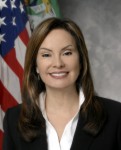
Treasurer of the United States Rosie Rios
The BEP will allow visitors to exchange notes on site and have a supply of new $100 Federal Reserve Notes to purchase for Rios’s autograph. Having a $100 note autographed by Rios would be interesting. Many people may not spend $100 to set aside for this type of collectible making it possible that it could increase in value. How many speculators will there be at her next autograph session?
Last chance!
As we approach the end of the year, the U.S. Mint announced that they will be ending sales of the 2013 5-Star Generals Commemorative Coin Program and Girl Scouts of the USA Centennial Silver Dollar. Also on the last chance are 2012 coin sets, 2012 Platinum American Eagles, and 2012 First Spouse coins.
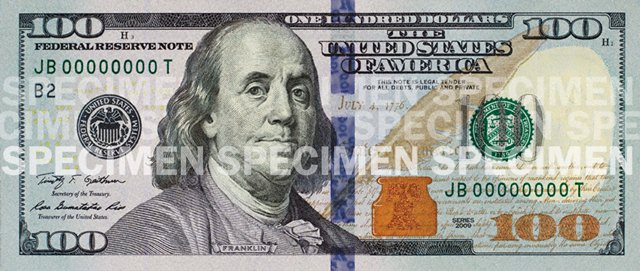
Will you trade $100 for a new $100 note to have it autographed by Treasurer of the United States Rosie Rios?
Nov 2, 2013 | BEP, coins, currency, legislative, policy, US Mint
Believe it or not, there was a little business actually being done by the congress other than the partisan bickering.
H.R. 3305 Currency Optimization, Innovation, and National Savings Act
Sponsor: Rep. Michael Fitzpatrick (R-PA)
• To improve the circulation of $1 coins, to remove barriers to the circulation of such coins.
• Introduced: October 22, 2013
• Referred to the House Committee on Financial Services
Track this bill at http://www.govtrack.us/congress/bills/113/hr3305
Oct 13, 2013 | BEP, coins, currency, news, US Mint, web
On Friday, the U.S. Mint and the Bureau of Engraving and Printing announced that they would be cross-promoting each other’s products. As one of the few agencies in full operation, the U.S. Mint and BEP updated their website with two pages, one provides information about the other agency and the other points to their online store.
This probably would have gone unnoticed except for the email announcement sent by the Bureau of Engraving and Printing to subscribers. It was sent in such haste that the link they provided to the U.S. Mint’s site is broken.
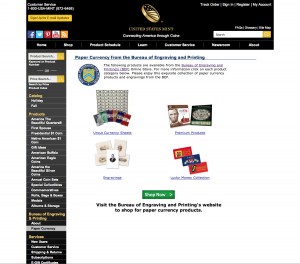
Promoting BEP’s Currency at the U.S. Mint
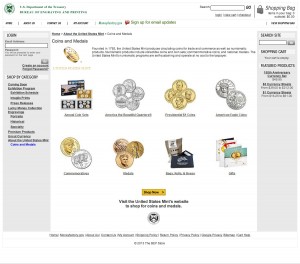
Promoting U.S. Mint’s coins at the BEP
Click on the preview to visit the site.
I bet you thought there was no good news to come out of Washington, D.C. last week!
Oct 10, 2013 | BEP, currency, dollar, Federal Reserve, news, video
 With the fanfare of a hard cough, the Federal Reserve released the new $100 Federal Reserve Note on Tuesday, October 8, 2013 to financial institutions. Various factors will effect how quickly these notes are seen in circulation including the demand and ordering policy of the financial institutions. In fact, the launch was introduced with a video by Sonja Danburg, Program Manager of the U.S. Currency Education Program at the Federal Reserve.
With the fanfare of a hard cough, the Federal Reserve released the new $100 Federal Reserve Note on Tuesday, October 8, 2013 to financial institutions. Various factors will effect how quickly these notes are seen in circulation including the demand and ordering policy of the financial institutions. In fact, the launch was introduced with a video by Sonja Danburg, Program Manager of the U.S. Currency Education Program at the Federal Reserve.
This launch is three years in the making as Bureau of Engraving and Printing reported problems with folding during the printing of the new notes. The announcement on April 21, 2010 said that the new notes would be released on February 10, 2011. On October 1, 2010, the Federal Reserve announced that the new note would be delayed. Later, the folding problems were revealed following a report released by the Treasury Office of the Inspector General.
The reason for the new notes are for the addition of security features. Aside from the ecurity thread, portrait watermark, color-shifting ink, microprinting, and the strategic use of color, the new note has a 3-D security ribbon and the use of color-shifting ink used to reveal a bell in the inkwell. If you look at the blue ribbon on the front of the note, tilt the note and watch the bells on the ribbon change to “100s” as the reflection of light changes. The 3-D ribbon is embedded in the paper and not printed. Looking at the copper-colored inkwell on the front of the note, tilting the note will reveal a bell that was embedded using color-shifting ink. Using these light sensitive features, the Federal Reserve hopes to significantly reduce the number of counterfeit notes, especially overseas where half of the $100 notes are known to circulate.
The Federal Reserve released a video about the new anti-counterfeiting features:
As an aside, the Bank of England recently announced that they will be transitioning to polymer banknotes by 2015.
Sep 30, 2013 | BEP, coins, currency, Federal Reserve, news, policy, US Mint
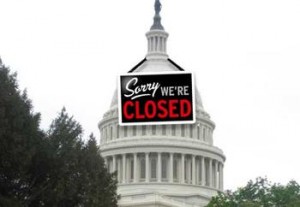 In the ongoing drama that is United States Federal government, a shutdown is looming over the shear idiocy of idiot-loges on both sides of the aisle attempting the rule and not govern. All 537 politicians elected to federal office are in need of a good spanking.
In the ongoing drama that is United States Federal government, a shutdown is looming over the shear idiocy of idiot-loges on both sides of the aisle attempting the rule and not govern. All 537 politicians elected to federal office are in need of a good spanking.
First, here are some impacts:
- According to the Office of Management and Budget, a government shutdown will cost taxpayers an extra $40-60 million per day.
- The District of Columbia is reporting that a shutdown will cost the city about $2 million per day in lost revenues.
- Maryland and Virginia has not reported their potential economic impact of a shutdown.
- UPDATE (4:40pm): Local news reports say that over 835,000 workers will be effected by a shutdown with at least 80-percent being in the Washington, D.C. metropolitan area. Some estimates are saying that it could cost the region up to $20 million per day.
What does this mean for the money manufacturing bureaus of the country?
- The U.S. Mint is not answering inquiries about pending shutdown. Media is directed to contact OMB for more information.
UPDATE (1:40pm): The U.S. Mint will not allow tours of the Philadelphia and Denver mints during a government shutdown.
- Office of Management and Budget is not answering the telephone. Rather, they requested that an email be sent with detailed questions. Email inquiries have yet to be answered.
- When calling the Bureau of Engraving and Printing, their phone is either busy or when trying to get past the voice response system for the Office of External Relations, the system says “the person you attempted to reach is unavailable.” An email was sent to the BEP’s general inquiry account and OMB asking about the operations at the BEP.
UPDATE (3:30pm): An email note was received from the BEP saying to contact a spokesperson at the Department of the Treasury. Telephone and email messages have not been returned.
UPDATE (4:10pm): Both the Washington and Fort Worth plants will not hold tours if there is a government shutdown at midnight tonight.
- Since the Federal Reserve is an independent organization and not subject to congressional appropriations, they will remain open during a shutdown. The shutdown will not affect the launch of the new $100 Federal Reserve Note planned for October 8.
UPDATE (5:30pm): According to the Treasury Department:
Operations of the following bureaus are funded from sources other than annual Congressional appropriations, and would operate normally if a government shutdown were to occur: the Office of the Comptroller of the Currency (OCC), the United States Mint, and the Bureau of Engraving and Printing (BEP).
This post will be updated as new information is provided.
Representatives of these agencies may contact me via email to provide additional information. Please note that I do respect the confidentiality of sources!
NOTE: I am not a member of any political party. I am a proponent of government employees who do not deserve the way they are being treated by the elected officials.

























